Ultra Precise Motion Tracking in Multilayer Zone Plate Imaging
In hard X-ray imaging, the average scanning time per probe is an essential parameter to reduce beam damage spreading. In addition, the real-time resolution can be strongly affected by vibration or drift of the setup. In ptychographic experiments like crystallography, the scanning time mainly depends on the setup’s stability.
attocube's interferometer FPS3010, a former version of the IDS3010, was used to optimize the stability of a newly developed experimental setup composed of Multilayer Zone Plate (MZP) optics as well as a MZP based piezo sample scanner. This was tested at the P10 beamline at the PETRA III synchrotron (DESY Photon Science).
The interferometer detected crosstalk generated by vibration and shocks caused by sample alignment motors. Based on these measurements, the setup’s imaging resolution was reduced down to +/-10 nm.
This measurement was realized with the Displacement Measuring Interferometer.
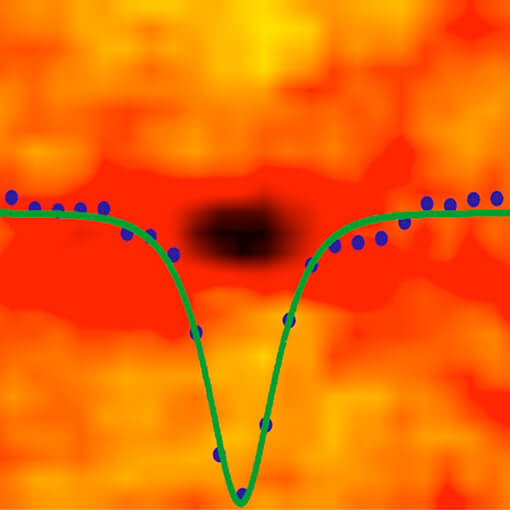
Sample positioning in scanning transmission x-ray microscope at SLAC
We use attocube linear stages with optical and resistive encoders for positioning of samples relative to high resolution x-ray optics in a scanning transmission x-ray microscope. The picture shows a magnetic excitation called “soliton” that is the result of a spin polarized current injected into a thin ferromagnetic Co/Pt multilayer. The injected spin causes a localized oscillation of the magnetization at the spot where the current is injected, here a nano contact with a 150 nm diameter in the center of the picture. Time resolved scanning transmission x-ray microscopy using magnetic circular dichroism as a contrast mechanism is used to obtain an image of the magnetic soliton.
(Dr. Hendrik Ohldag, Stanford Synchrotron Radiation Laboratory, SLAC National Accelerator Laboratory.)
This measurement was realized with the ANPx101/UHV - linear x-nanopositioner, and the ANPz102/UHV - linear z-nanopositioner.
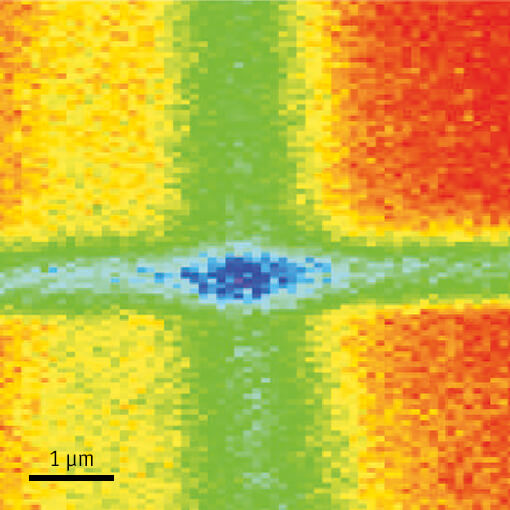
Characterizing a scanning fluorescence X-ray microscope
When developing an X-Ray microscope capable of nm resolution, careful design is a must. Thermal and mechanical stability of the components and assemblies has to be followed throughout the process. The FPS shows superior performance regarding its outstanding stability and its capability of measuring sub-nm displacements. The senor has a better than 1.25 nm stability over 40 hours, and a better then 300 pm resolution at 100 Hz bandwidth in a controlled environment. The FPS is therefore the ideal supplement for the mechanical control of all components used in the described X-Ray microscope setup achieving a resolution in the order of 40 nm, while the stability is below 45 nm over the entire time needed for data collection.
This measurement was realized with the Displacement Measuring Interferometer.

Nanometer Precise Positioning During Sample Rotations
Synchrotrons are electron particle accelerators that provide high-brilliance x-ray beams for experimental end-stations where it is used to study properties of different materials. These x-rays, having high penetration capabilities and highly focused beams, are often used in image scans where motion positioning systems play a primal role.
X-ray nano-imaging necessitates positioning systems with high constraints in mechanical construction as well as position metrology. In-axis and crosstalk motion errors, from linear as well as rotational drives, are always present and notably troublesome at nanometer-precision scans. Rotational drives are particularly difficult to characterize in respect to axial runout and wobble.
This measurement was realized with the Displacement Measuring Interferometer.
Lensless Imaging with X-Ray Waveguides
A synchrotron generated X-Ray beam was coupled into an X-Ray waveguide located in the focus of Kirkpatrick-Baez mirrors. The resulting filtered wave was then used to illuminate a sample coherently, yielding a magnified hologram of the sample recorded by a pixel detector. Several linear positioners, goniometers, and rotators were applied for precision alignment of the waveguide with respect to the sample, which in turn was mounted on a high-precision tomographic rotation stage.
This measurement was realized with the ANPx101/UHV - linear x-nanopositioner.
Further reading:
S. Kalbfleisch et al., AIP. Conf. Proc., 1234, 433-436 (2010)


New Stable and Portable X-Ray Microspectroscope at KEK
At the high energy research accelerator KEK in Japan, Dr. Takeichi et al. designed a novel X-Ray microspectroscope for high resolution composition analysis. The setup is comprised of 11 attocube ECS stepping positioners and a dedicated scanner for sample imaging. All the positioners are equipped with optoelectronic sensors and can be digitally controlled. The sample stage is stabilized via attocube’s interferometric FPS3010 sensor with a resolution of 25 pm. The whole four-stack-setup is compact enough to fit into a vacuum chamber of only 220×310×200 mm3. First measurements show the resolution of the new instrument to be approximately 40 nm.
This measurement was realized with the ECSx3030/StSt/HV, and the .
Further reading:
Y. Takeichi, et al, Rev.Sci.Instr. 87, 013704 (2016)


Lensless Imaging with X-Ray Waveguides
When developing an X-Ray microscope capable of nm resolution, careful design is a must. Thermal and mechanical stability of the components and assemblies has to be followed throughout the process. The FPS shows superior performance regarding its outstanding stability and its capability of measuring sub-nm displacements. The senor has a better than 1.25 nm stability over 40 hours, and a better then 300 pm resolution at 100 Hz bandwidth in a controlled environment. The FPS is therefore the ideal supplement for the mechanical control of all components used in the described X-Ray microscope setup achieving a resolution in the order of 40 nm, while the stability is below 45 nm over the entire time needed for data collection.
Further reading:
E. Nazaretski et al., Rev. Sci. Instrum., 84, 033701 (2013)
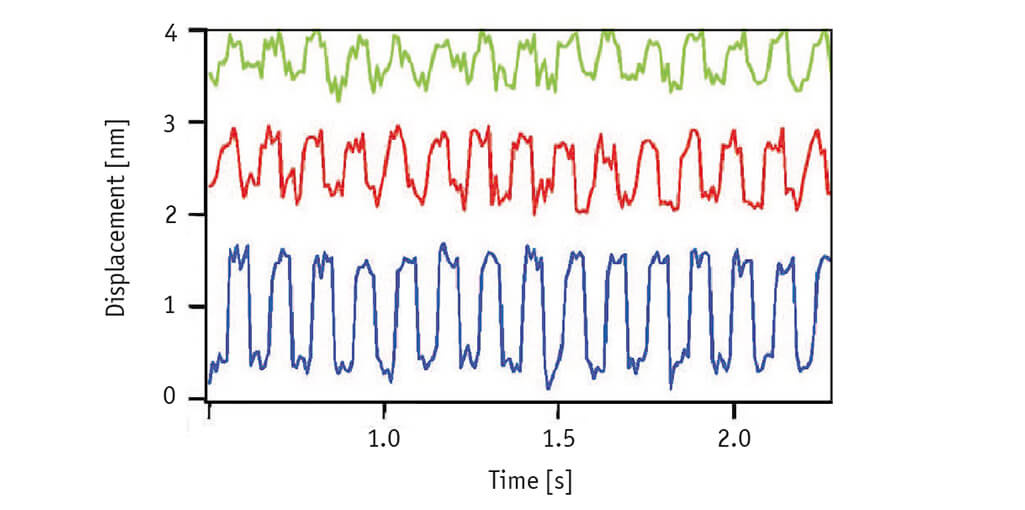
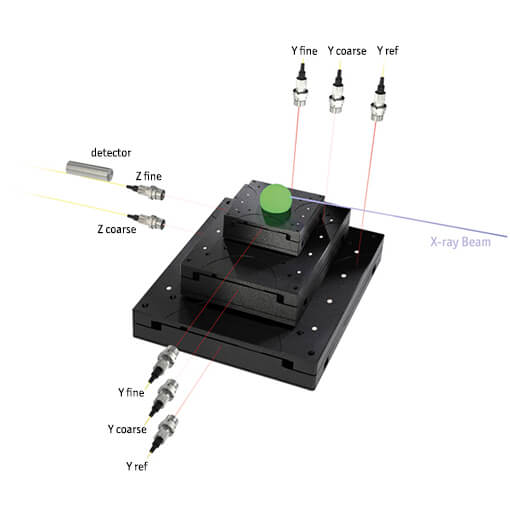
Detecting vibration propagation and parasitic motions with picometer resolution
Exact sample positioning in synchrotron beamlines requires position detection with highest resolution. A group at the Diamond Light Source designed a sample positioning system with three positioners for x, y, z movements. To determine the error motions, eight axes of three IDS3010 devices were triggered for synchronous data acquisition, controlling the movement with BiSS-C interface. They identified parasitic motions of only 100 pm that were caused in the non orthogonal fixing of the positioners. These smallest amount of deviation can be detected in Ultra-high vacuum only - and with the IDS3010.
(Trevor Bates, Brian Nutter, Diamond Light Source Limited, Oxfordshire, England)
This measurement was realized with the ECSx5050/Al/RT, and the Displacement Measuring Interferometer.
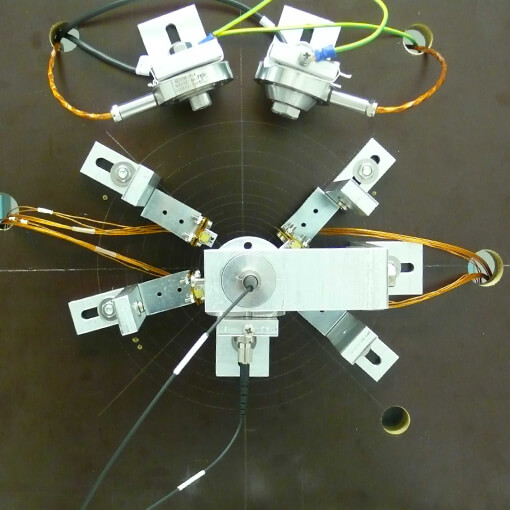
Laser Interferometry in Radiation Harsh Environments
attocube’s award winning FPSensor is now available with radiation hard sensor heads. Among the existing sensor portfolio, the “M12”sensor head has been qualified for the operation in radioactive environments at radiation doses of up to 10MGy.
The qualification process was conducted using a Co60 source and was succsefully tested by CERN and Fraunhofer Institute.
This measurement was realized with the Displacement Measuring Interferometer.
Vibration of high-power precision laser mirror
At the “ELI Beamlines facility”, currently under construction in Dolní Brežany close to Prague in the Czech Republic, we have developed an ultra-high pointing stability laser mirror mount for guiding the world’s highest repetition rate HAPLS Petawatt laser over up to 107 meters onto the target. The attocube IDS3010 offers major advantages compared to standard sensors like capacitive probes and accelerators when measuring 5 - 100 nrad RMS pointing stability of a mounted high-power precision laser mirror. While accelerometers may be used to measure mirror dummies for frequencies >≈12 Hz, the IDS3010 interferometer may diagnose contactless sub-nm displacements up to 10 MHz of mounted mirrors without risking the degradation of its laser damage threshold. In addition the IDS3010 sensor allows working distances up to a few meters. The software WAVE has proved to be convenient for visualizing in real-time the displacement data and for identifying resonant frequencies.
(Dr. Tomas Laštovicka, Dr. Martin Sokol, Dr. Michael Morrissey, Ing. Antonin Fajstavr, Dr. Stefan Borneis ELI-Beamlines, Dolní Brežany, CZ)
This measurement was realized with the Displacement Measuring Interferometer.
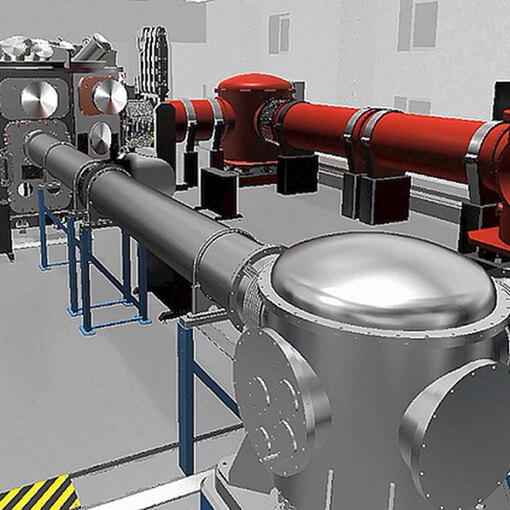
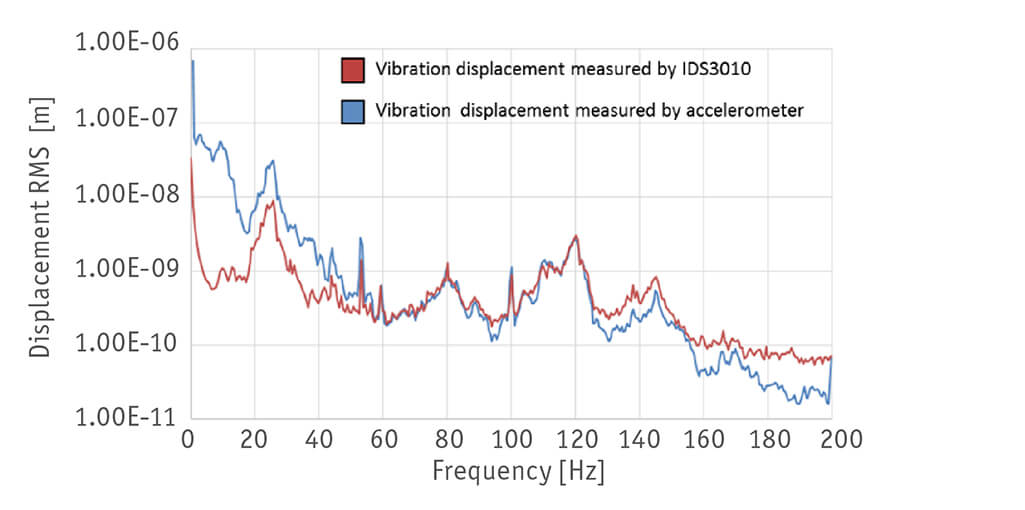
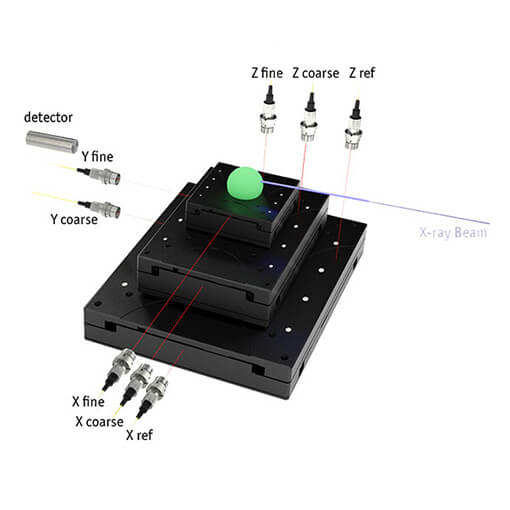
Interferometric Multi-Axis Motion Control of an X-Ray Setup
In high precision systems for moving objects in nanometer ranges, error motions and vibration propagation are crucial information for the motion accuracy. Due to this, synchrotron facilities continue to develop and upgrade different components to keep pace with the latest available technologies. The beamline I08 recently upgraded the end-station using attocube interferometers IDS3010 with BiSS-C interface. An experimental setup at the Diamond Light Source is synchronously triggering and tracking the movement of eight different linear axes. These eight axes were controlled by the Delta Tau “GeoBrick” controller, which ensures the accurate timestamped data from all eight axes, i.e. three IDS3010 devices.
The setup consists of three motion modules as shown in a simplified version in the upper figure: from the bottom one manual positioner, on top of it one stepper motor for more coarse adjustments, and finally on top of that one piezo-based positioner for fine motions. All three modules can move in X-, Y-, and Z-direction, i.e. the complete setup consists of 9 linear movements, and is being tracked by 8-axes consisting of M12/C1.6 high vacuum compatible sensor heads. Since the sample’s position is relevant for each movement of the three modules, every motion axis needs to be tracked. There are two kinds of error motions (parasitic movements) relevant for the sample’s position: vibrations caused by moving the positioner that spread to connecting positioners and the sample, as well as uneven motions caused by non-parallel mountings between the positioners.
One measurement example is shown in the lower figuer, which only involves the X, Y, and Z piezo-based positioners in the upper module. The two parasitic movements are shown while moving the fine piezo positioner in the X-direction using 5 nm step sizes. The red line (X-axis) shows the positioner moving in one direction, after 10 steps, the positioner is moving back with one 50 nm step. The blue line (Y-axis) shows the error motions of the fine positioner orthogonal to the motion of the positioner in the horizontal level. The noised oscillations are caused by vibration propagation emerging from the positioner’s motions. This line shows a linear offset of 10 pm for every step. This offset originates from the not perfect parallel mounting between the X- and Y- positioners. This non orthogonal mount can be compensated using the information for the other axes. The green line (Z-axis) shows the vertical movements of the fine positioner. Only the last step of 50 nm shows a significant change of the vertical position, presumable due to a rapid vibration.
(Diamond Light Source Limited, 2017)
This measurement was realized with the Displacement Measuring Interferometer.
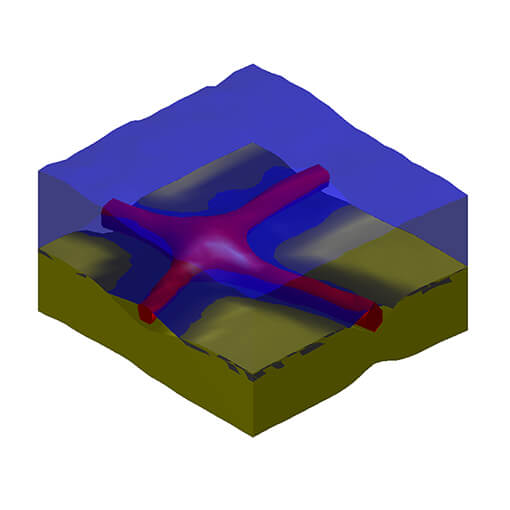
Micro X-Ray Fluorescence Analysis Spectrometer
Confocal micro-XRF is a method to determine the spatial distribution of major, minor and trace elements within a sample in three dimensions. The employed polycapillary x-ray optics need to be aligned precisely to get optimal results. Very compact positioners had to be used inside the vacuum chamber for this purpose. Long-time stability of the alignment is also a major requisite. ANPxyz101 nanopositioners fulfill these requirements very well.
The figure to the left shows a 3D sample measurement of a cross made from 10 µm copper wire which is placed on an x-ray screen and fixed using adhesive tape.
(The data was kindly provided by S. Smolek and C. Streli, Atominstitut of the TU Wien.)
Hypersensitive macroscopic manipulation of quantum many-body states
M. Bartkowiak, S. Gerber and M. Kenzelmann from the Paul Scherrer Institut, Switzerland, have developed a goniometer sample holder for neutron scattering, which permits in-situ tuning of complex quantum states at low temperatures (100 mK) and high magnetic fields (up to 12 T) [1]. The device is based on a purpose-built, non-magnetic ANGt50/LT goniometer of attocube’s cryogenic, open loop positioners. It has an angular range of ±3.6° and is sufficiently compact to fit a dilution refrigerator - cryomagnet environment.
With this device, the magnetic domain population in so-called Ce-115 superconductors could be controlled by altering the alignment of the sample to the magnetic field direction [1,2]. Therewith a binary switching behavior has been found which provides strong evidence for a direct coupling of magnetism and unconventional superconductivity in the vicinity of quantum criticality. Population of the Qh (orange) and Qv (grey) magnetic domains in the so-called Q-phase of the compound CeCoIn5 is shown as a function of the tilt angle with respect to the external magnetic field. For |Ψ| = 0.05° a mono-domain population is found, which can be macroscopically switched (modified from [1]).
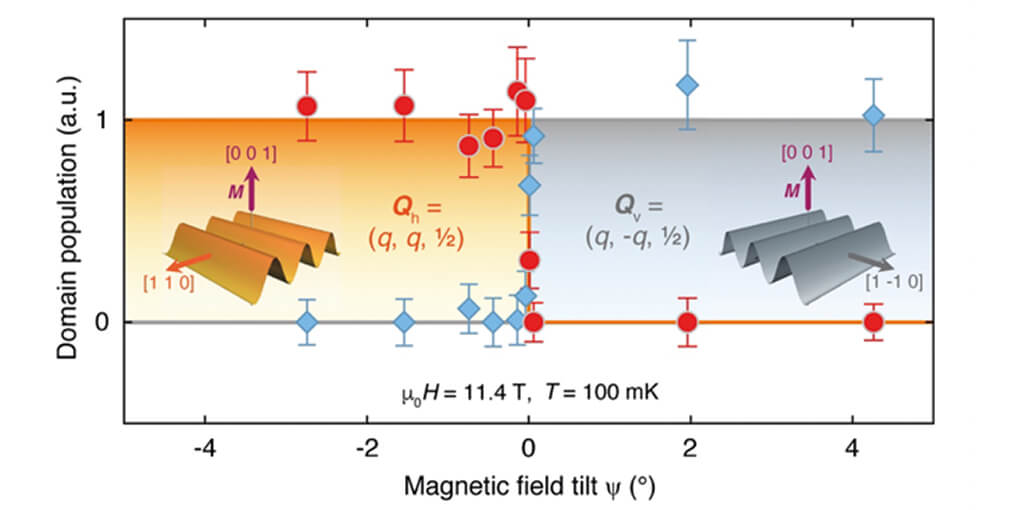
Rotation motion error compensation for stable probe positioning
The challenge of rotatory probe positioning for x-ray nanotomography is the limited tolerance of the runout. The smaller the runout - the better the resolution of experiments. The closed loop system at the synchrotron SOLEIL consists of a positioning stage for rotating the probe and attocube‘s interferometer focusing directly on the rotating cylinder. The positioning stage is equipped with three linear drives, two piezo driven positioners for compensation of error motions, and one rotational stage. Based on a reduction algorithm for error motions, the initial runout of 1250 nm is reduced to 42 nm - a decrease of 97%.
(Christer Engblom, Synchrotron Soleil, St Aubin, France)
This measurement was realized with the Displacement Measuring Interferometer, and the .
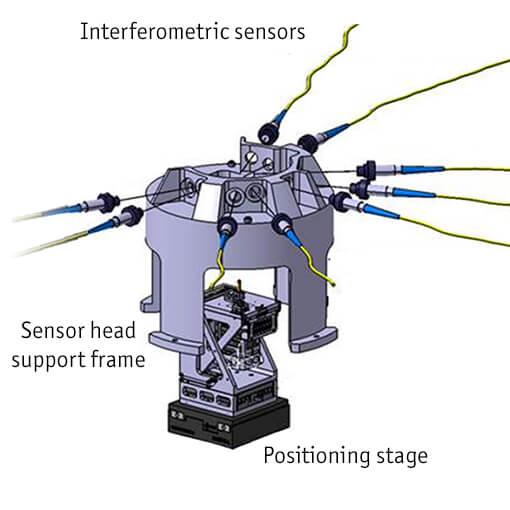
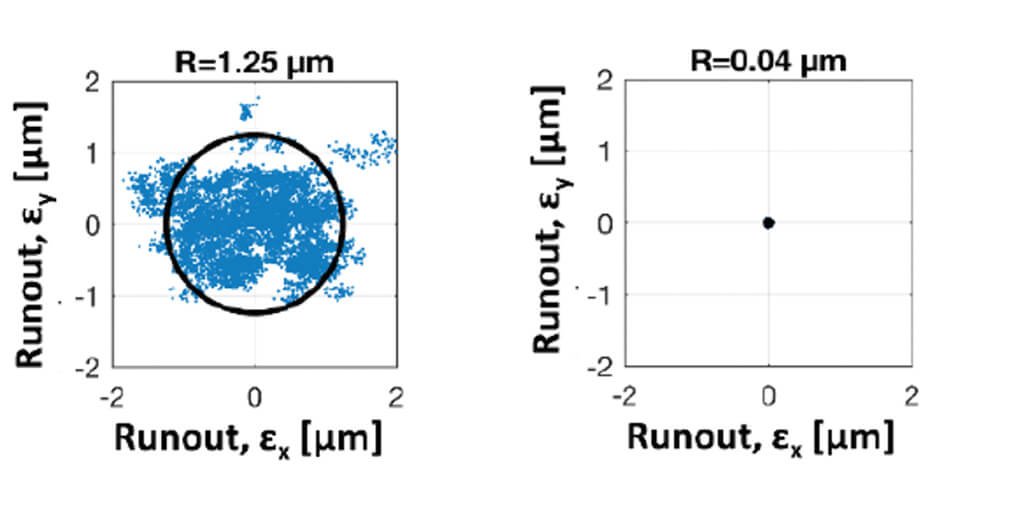
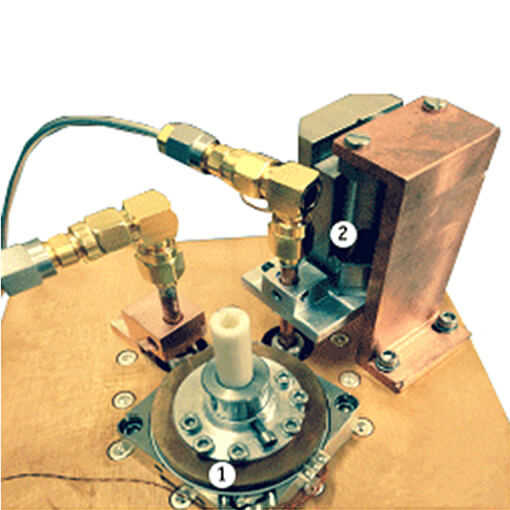
The Axion Dark Matter eXperiment - Nano Precision in Extreme Conditions
The Axion Dark Matter eXperiment (ADMX) seeks to prove the existence of the axion and reveal the composition of dark matter by looking for the resonant conversion of dark-matter axions to microwave photons in a strong magnetic field. The new high-frequency Sidecar experiment, developed by Christian Boutan at the University of Washington (now at the Pacific Northwest National Laboratory) is a miniature axion haloscope that fits inside of the ADMX insert and has the capability of searching for axion masses between 16µeV - 30µeV. Two positioners are required for the essential functions of tuning the cavity and adjusting the antenna coupling at mK temperatures in a 8 Tesla field. attocube's ANR240/RES and ANPz101eXT12/RES were employed in this pathfinder experiment.
This measurement was realized with the ANR240/RES/LT - rotator (360° endless), and the ANPz101eXT12/RES/LT - linear z-nanopositioner.
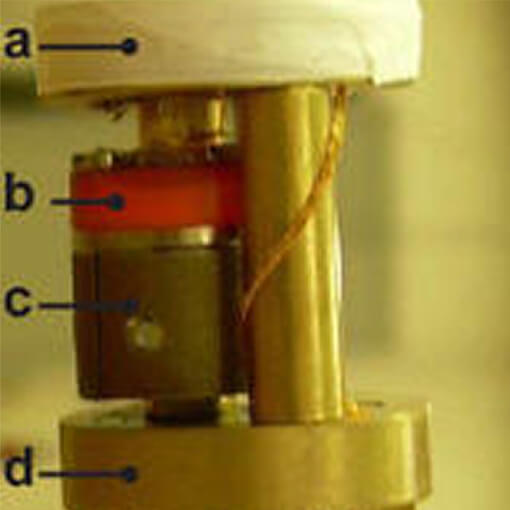
Performance Test of the ANPz30/LT at 35 mK and 15 Tesla
The precise performance of nanopositioning elements is of great importance in order to realize instrumental setups which work reliably under extreme environmental conditions. Although attocube systems’ positioners have been tested at low temperatures down to 10 mK and at high magnetic fields up to 28 Tesla, their successful performance has never been demonstrated when both environmental conditions were simultaneously applied. A real challenge, furthermore, is to carry out such a test in a 3He/4He environment due to the fact that 3He carries a magnetic spin which becomes polarized in magnetic fields. This influence on the positioner’s operation was investigated for the first time in this application.
This measurement was realized with the ANPz30/LT - linear z-nanopositioner.

